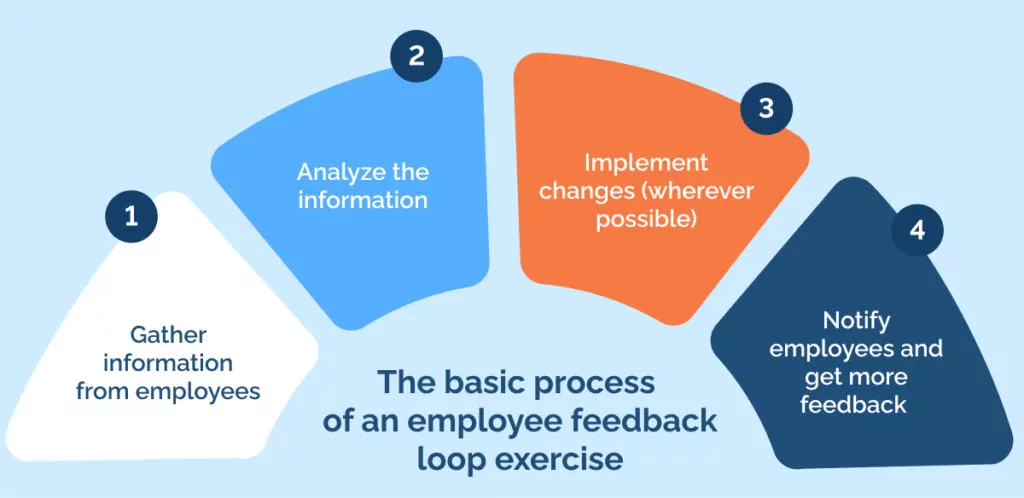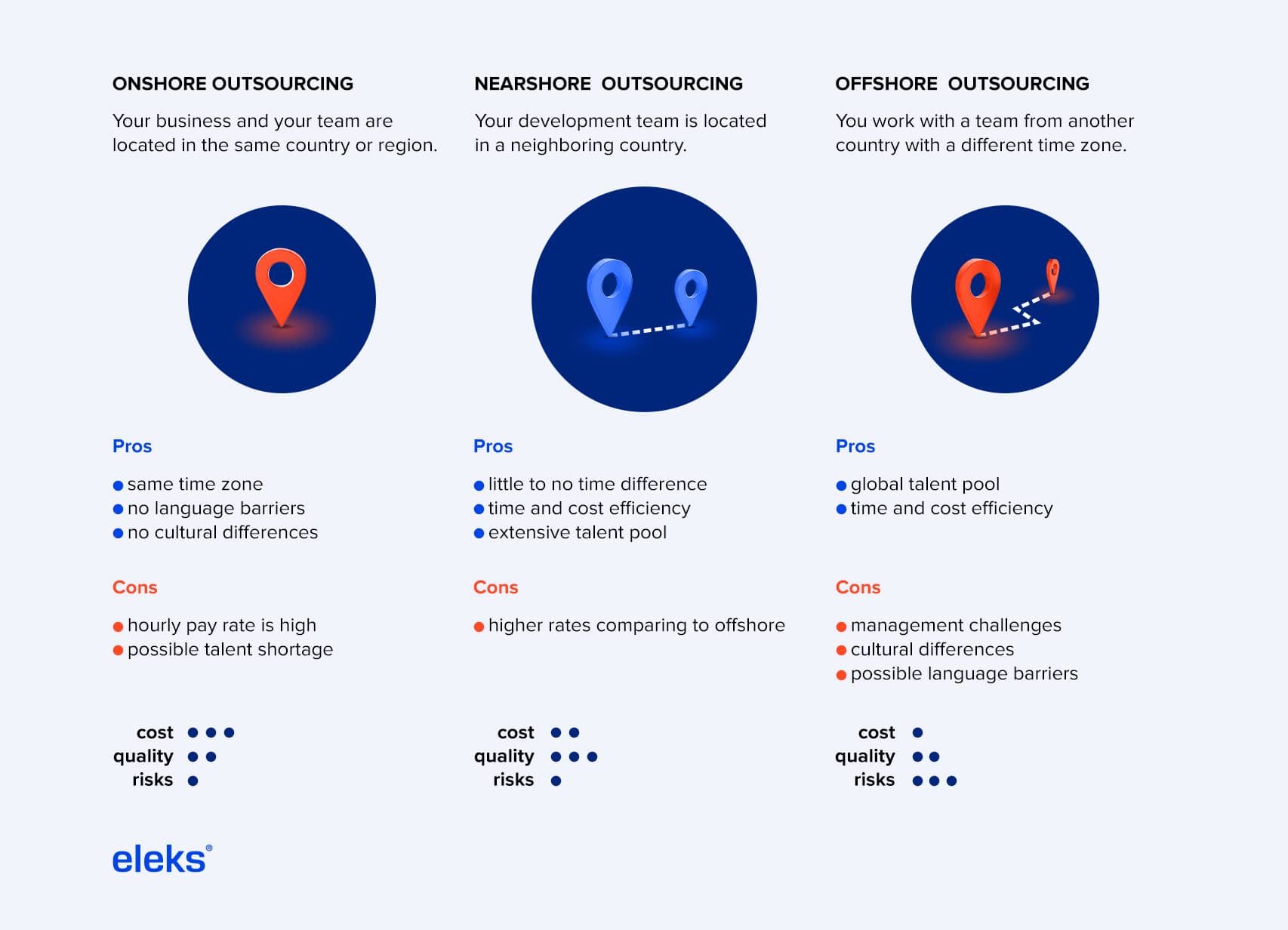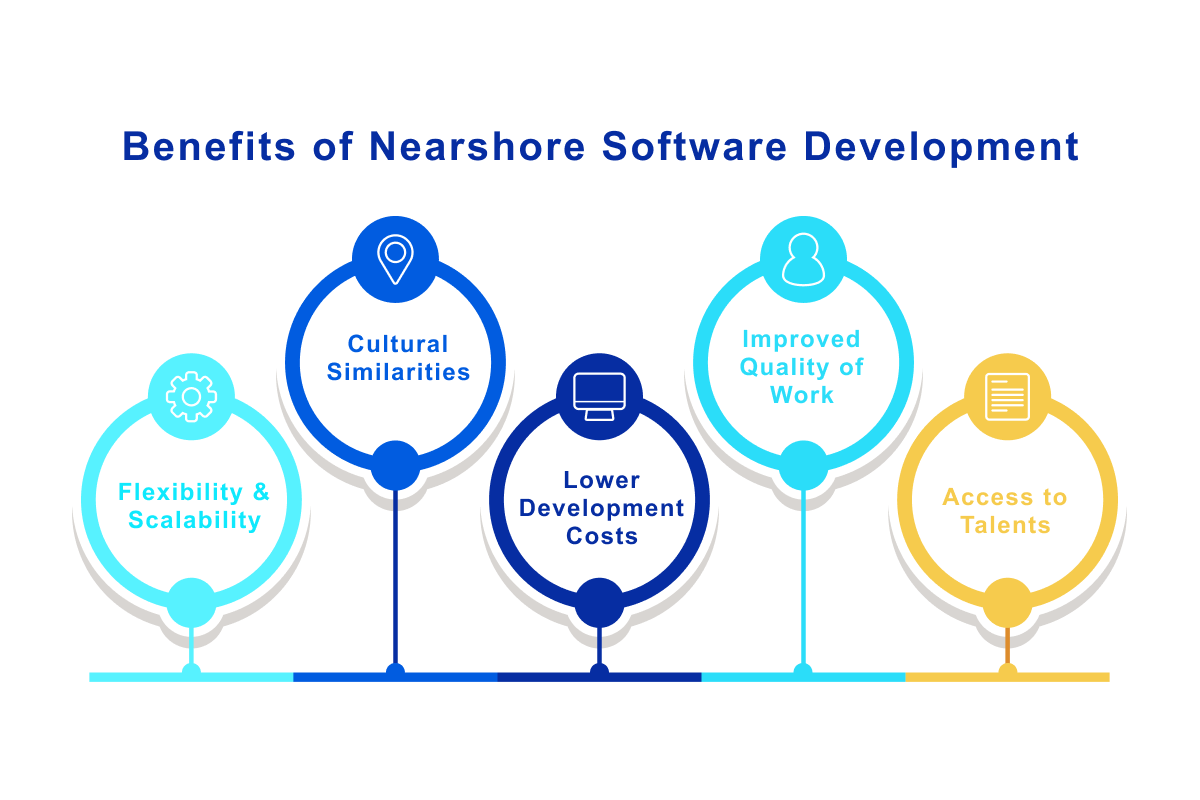The landscape of cross-border team leadership is undergoing a remarkable transformation. By 2025, projections indicate that over 70% of technology enterprises will collaborate with teams in neighboring nations. This strategic shift reflects a carefully calculated response to evolving business dynamics where the convergence of talent accessibility, cost efficiency, and geographical proximity becomes increasingly crucial.
Picture this scenario: Your development team spans across three countries. As your workday begins at 9 AM, your core development team is already an hour into their day, and a critical project milestone looms on the horizon. The question becomes: How do you orchestrate seamless collaboration across these distributed teams?
The dynamics of managing teams in nearshore environments have evolved substantially. Traditional management approaches are becoming obsolete as organizations navigate the complexities of time zone alignment, cultural integration, and communication effectiveness. These challenges, however, present unique opportunities for innovation in leadership approaches.
Drawing from my 15-year journey managing teams throughout the Americas, I’ve witnessed both extraordinary successes and significant setbacks. The distinguishing factor consistently revolves around mastering certain fundamental principles that often escape traditional management perspectives.
This comprehensive guide will explore:
– Advanced strategies for fostering cross-border team cohesion
– Innovative approaches to maximize productivity across time zones
– Effective methods for transforming cultural differences into competitive advantages
– Forward-looking management strategies aligned with 2025’s business environment
The hallmark of thriving nearshore teams consistently points to one critical factor: leadership that masterfully balances technical expertise with human-centric management approaches. This guide serves as your roadmap to developing these essential leadership capabilities.
Let’s delve into the proven methodologies and real-world strategies that drive successful nearshore team management, backed by concrete examples and practical applications.
Effective Strategies for Nearshore Team Collaboration
Picture this: A seamless workflow where teams collaborate effortlessly across borders, leveraging advanced communication platforms and well-defined processes. Let’s explore the key components that make this possible.
Consider this real-world scenario: A U.S.-based enterprise partnering with a development team in Mexico. This nearshore arrangement offers the advantages of aligned time zones and shared cultural understanding, creating a foundation for productive collaboration.
1. Use Technology for Real-Time Communication
As demonstrated by industry leaders, real-time communication platforms serve as the backbone of successful nearshore operations. Slack emerges as the go-to solution for instant messaging, while Zoom and Microsoft Teams deliver immersive video conferencing experiences that break down geographical barriers.

Future trends indicate these tools will evolve beyond basic communication. They’re projected to become collaborative hubs that foster genuine team connections and drive productivity. Have you ever thought about how quick responses can accelerate project timelines? However, strategic foresight suggests implementing boundaries to prevent communication fatigue and maintain team wellness.
[Action Items]
1. Ensure platform proficiency across team members.
2. Establish clear communication windows.
3. Develop consistent usage protocols.
[Dive Deeper]
– 2025 Solutions to Boost Productivity in Nearshore Teams
– Complete Guide to Nearshore Team Metrics and Tools
2. Establish Clear Goals and Roles
Let’s explore the breakdown of effective goal-setting through the SMART framework: Specific, Measurable, Achievable, Relevant, and Time-bound. This structured approach, combined with well-defined roles, creates a roadmap for success.
Highlighting a case study: A cross-border marketing initiative where team members managed distinct channels demonstrated the long-term benefits of role clarity. The key differences between successful and struggling teams often lie in their ability to balance autonomous operation with appropriate oversight.
[Action Items]
1. Implement comprehensive role documentation.
2. Deploy goal-tracking systems.
3. Schedule periodic strategy reviews.
[Dive Deeper]
– Proven Tips and Steps for Creating a High-Performance Nearshore Team
– Practical Strategies for Building Nearshore Teams in 2025
3. Regular Team Meetings and Feedback
Anticipated developments in team collaboration emphasize the vital role of structured meetings. Regular check-ins create a rhythm that ensures alignment and provides a platform for meaningful dialogue and progress tracking.

The advantages of a robust feedback system extend beyond immediate performance improvements. You may wonder about the best approach – the answer lies in fostering an environment where constructive feedback flows naturally in all directions, building resilience without crossing into negative territory.
[Action Items]
1. Implement structured meeting frameworks.
2. Create multi-directional feedback channels.
3. Deploy periodic anonymous feedback mechanisms.
[Dive Deeper]
– Comprehensive Guide to Nearshoring Compliance in 2025
– 2025’s Data-Driven Nearshore Outsourcing Business Models
Quick note: This guide assumes familiarity with building a high-performance nearshore team. If you found yourself wondering about effective strategies for team management in nearshore locations, check out our complete breakdown of building high-performance nearshore teams first. It covers all the essentials you’ll need to make the most of this team management guide. Already comfortable with the basics? Perfect – let’s proceed…
1. Advantages of Nearshore vs Onshore Management

- Strategic cost optimization through nearshore partnerships
- Seamless workflow synchronization
- Access to diverse talent ecosystems
1. Cost-effective Solutions
Let’s explore how nearshore teams dramatically transform cost structures. Picture this: companies typically experience a 30-40% reduction in operational expenses compared to onshore alternatives. Key differences emerge in infrastructure costs, compensation packages, and overhead expenses across nearshore locations. This strategic approach enables more precise budget forecasting while maintaining quality standards. Consider this: a recent Deloitte analysis reveals cost optimization as the primary driver for 33% of businesses choosing nearshore partnerships. Yet the advantages extend beyond immediate savings. Organizations gain remarkable financial flexibility, enabling strategic scaling without substantial risk exposure. This adaptability proves invaluable during market fluctuations.
The projected growth in nearshore adoption often translates into strategic reinvestment opportunities. As illustrated by real-world scenarios, companies redirect substantial savings from reduced labor costs into innovation initiatives. This reinvestment cycle catalyzes organizational growth and technological advancement. For a comprehensive breakdown of strategic benefits, explore why 80% of companies switch.
2. Proximity Benefits
Time zone alignment represents a crucial competitive advantage in global operations. Nearshore partnerships typically operate within complementary time zones, enhancing collaborative potential. Strategic foresight in scheduling eliminates communication delays, maximizing opportunities for real-time interaction. This synchronization transcends basic scheduling benefits, fundamentally enhancing operational efficiency.
Have you ever thought about the long-term impact of travel logistics? Nearshore locations offer streamlined travel arrangements. Leadership teams benefit from reduced travel times and abundant direct flight options. This accessibility nurtures essential face-to-face relationships, particularly crucial for high-priority initiatives. Highlighting the human element, geographical proximity strengthens team cohesion through regular personal interactions.
3. Access to a Large Talent Pool
Nearshore partnerships unlock access to expansive specialist talent pools, particularly in emerging tech hubs. Case study evidence shows education systems in key nearshore regions increasingly align with industry demands. For example, technological centers across Latin America and Eastern Europe deliver exceptional expertise at competitive rates compared to traditional markets. This specialized knowledge base offers strategic advantages for organizations seeking specific skill sets.
The anticipated developments in nearshore talent pools extend beyond technical capabilities. Diverse professional backgrounds contribute unique problem-solving approaches. This cultural diversity drives innovation through varied perspectives and methodologies. Teams leveraging these different viewpoints often develop more innovative solutions, enhancing project outcomes. Discover more about identifying top nearshore developer talent through specialized resources.
4. Enhanced Agility and Scalability
Nearshore collaboration introduces remarkable operational flexibility. Strategic foresight enables rapid team scaling based on evolving project requirements. This adaptability proves essential, particularly in dynamic sectors experiencing rapid change. Nearshore agreements typically offer more flexible terms compared to traditional onshore contracts. This framework allows organizations to adapt to market shifts or scope changes without significant contractual complications.
The scalability advantage extends beyond team dynamics. Future trends indicate increasing emphasis on technological adaptation and process evolution. Nearshore locations demonstrate exceptional adaptability regarding technological transitions and methodology updates. This flexibility ensures organizations maintain competitive advantages without substantial resource investment. Businesses gain enhanced capability to navigate emerging market opportunities.
5. Strong Relationships and Collaboration
Geographical proximity and operational flexibility foster robust team relationships. This translates into enhanced communication patterns and collaborative initiatives. Regular strategy sessions and ideation meetings become seamless components of project workflow. Frequent interaction builds trust and deeper understanding of diverse working methodologies.
Face-to-face engagement cultivates strong organizational culture and professional connections. Organizations consistently report that physical proximity facilitates both professional knowledge exchange and personal connection. This environment nurtures creativity and innovation. The combination of streamlined communication and team cohesion results in superior project execution and reduced operational friction.

Understanding these strategic advantages empowers organizations to make well-informed partnership decisions. For those seeking deeper insights, exploring specialized aspects can further enhance management effectiveness.
Overcoming Communication Challenges in Nearshore Teams
Let’s explore these key strategies:
– Strategic cultural alignment enhances team dynamics
– Targeted language development drives clarity
– Advanced visualization techniques unlock collaboration
Have you ever thought about the unique communication landscape in nearshore teams? Consider this: while teams span different countries, the right approaches can transform potential barriers into bridges of understanding.
Build a Strong Communication Culture
Leveraging Cultural Intelligence
Picture this: cultural awareness serves as the foundation for exceptional teamwork. Real-world scenarios demonstrate how understanding cultural nuances accelerates project success and drives innovation. For example, differences in decision-making approaches or communication preferences can significantly impact project timelines.
As demonstrated by forward-thinking organizations, cultural intelligence pays dividends. Take the case study of a Silicon Valley software company partnering with their Costa Rican team. After implementing cultural intelligence workshops, they reported a 40% reduction in miscommunication incidents.
[Action Items]
1. Launch monthly cross-cultural exchange initiatives
2. Implement comprehensive cultural intelligence training
3. Create structured feedback channels for cultural insights
Key differences matter: Research shows that addressing cultural dynamics can accelerate project delivery by up to 25%.
Fostering Transparent Communication
Strategic foresight shows that trust-based environments amplify team performance. Creating dedicated spaces for both structured and informal dialogue strengthens team bonds and accelerates problem-solving. Future trends indicate that transparency will become increasingly crucial for distributed teams.
Highlighting successful implementations, consider a fintech startup that introduced “Innovation Forums” – weekly spaces for open dialogue. The projected growth in team efficiency reached 35% within three months.
[Action Items]
1. Establish bi-weekly feedback roundtables
2. Deploy advanced feedback platforms
3. Recognize and reward transparent communication
Language Skill Enhancement
Strategic Language Development Programs
Long-term success in nearshore collaboration often hinges on language proficiency. Investing in comprehensive language development yields measurable returns in communication efficiency and team cohesion. Anticipated developments suggest that multilingual teams will have significant competitive advantages.
Let’s explore successful implementations: A product development firm’s partnership with language specialists led to a 45% improvement in requirement comprehension. For continuous improvement, platforms like Duolingo Enterprise offer structured team development.
[Action Items]
1. Design customized language development tracks
2. Create performance-based language incentives
3. Conduct quarterly language proficiency assessments
Strategic Translation Integration
You may wonder when professional translation becomes essential. The advantages of expert linguistic support become clear during complex technical discussions or critical negotiations. The breakdown of translation ROI often reveals surprising benefits.
Illustrated by real success: A multinational tech firm working with their Colombian team saw a 60% reduction in specification errors after introducing specialized technical translators.
[Action Items]
1. Map mission-critical translation requirements
2. Evaluate specialized translation services
3. Monitor translation impact metrics
Use Visual Communication Tools
Advanced Visualization Platforms
Visual collaboration tools represent the future of remote teamwork. Platforms like Miro and Lucidchart transform complex concepts into accessible visual narratives. The advantages include accelerated understanding and enhanced engagement across distributed teams.
Case study: A cross-border UX team spanning Texas and Argentina achieved 50% faster concept approval using advanced visualization techniques. Comprehensive resources like Miro’s enterprise training enhance implementation success.
[Action Items]
1. Roll out comprehensive visual tools training
2. Develop visual communication guidelines
3. Create visual collaboration playbooks
Visual communication transcends traditional barriers, creating universal understanding in distributed teams.
The comparison between traditional and visually-enhanced communication reveals compelling opportunities for team excellence.
Cultural Considerations in Nearshore Team Management
- Strategic cultural alignment enhances team performance and retention
- Cross-cultural training drives innovation and strategic decision-making
- Cultural integration creates sustainable competitive advantages
1. Understanding Local Business Etiquette
Consider this: business etiquette shapes every interaction within your nearshore team. Picture this: it’s not merely about formal greetings—it delves into fundamental cultural values that influence project dynamics. Real-world scenarios demonstrate how cultural awareness in nearshore team management impacts everything from strategic planning to conflict resolution. When team members experience cultural validation, their engagement skyrockets.
As demonstrated by various case studies, cultural approaches can vary significantly. For example, some business cultures prioritize direct communication, while others emphasize relationship-building before addressing challenges. Let’s explore how adapting to these nuances prevents potential roadblocks. The Complete Guide highlights the strategic importance of mastering both legal and cultural landscapes.
2. Training and Diversity Sensitivity
Strategic foresight in implementing comprehensive training programs proves crucial. Long-term diversity initiatives transform workplace dynamics. Cross-cultural workshops serve as the foundation, but their impact extends far beyond immediate benefits. They cultivate deep-rooted understanding and appreciation, addressing both contemporary challenges and anticipated developments in global team dynamics.
Key differences emerge when examining successful diverse teams. The advantages of varied perspectives manifest in breakthrough innovations and creative problem-solving. Beyond traditional workshops, forward-thinking policies must encompass everything from recruitment strategies to operational excellence.
3. Hosting Cultural Exchange Events
Cultural integration events yield measurable benefits. Whether leveraging virtual platforms or organizing in-person gatherings, these initiatives strengthen organizational bonds. Projected growth in virtual team engagement suggests focusing on culturally themed activities. For example, interactive cooking demonstrations highlighting regional specialties create meaningful connections beyond professional responsibilities.
Strategic cultural experiences deserve careful consideration. Highlighting specific examples, virtual museum tours or collaborative film discussions featuring regional cinema can bridge cultural divides effectively.
4. Adapting Communication Styles
The advantages of adaptable communication strategies cannot be overstated. You may wonder: does your team member prioritize relationship-building or direct data exchange? Such considerations must inform leadership approaches. For team leaders, understanding these key differences shapes everything from goal-setting to performance feedback. “Communicating Across Cultures” by Heather Bowe illustrates proven strategies for navigating these dynamics.
The disadvantages of communication misalignment can be substantial. Comparison studies show how stylistic disconnects can derail project timelines and strain relationships. Future trends indicate successful teams will increasingly prioritize communication style adaptation, including strategic choices in communication channels and methods.
5. Evaluating and Evolving Team Dynamics
Regular assessment proves essential in understanding team dynamics. Strategic foresight asks: do cultural values align with organizational objectives? This analysis drives necessary adjustments. As illustrated by industry leaders, management practices must evolve alongside team development. Anticipated developments in cultural assessment tools, including specialized surveys and expert consultations, help measure team cohesion and effectiveness.
Cultural integration presents both challenges and opportunities. Projected growth in global collaboration demands continuous learning and adaptation. Understanding these dynamics ensures teams achieve both diversity and unity.
The long-term advantages of prioritizing cultural considerations extend beyond good practice—they represent strategic necessity. These resources and insights provide a foundation for building thriving nearshore teams in an increasingly connected world.
Trends and Changes in Nearshore Team Management for 2025
Let’s explore the key differences shaping the future landscape:
– Strategic foresight in hybrid workplace evolution
– Real-world scenarios of AI integration
– Long-term ESG implementation strategies
Increased Focus on Hybrid Work Models
As demonstrated by current market shifts, hybrid work represents more than alternating between locations. It’s fundamentally reshaping how nearshore teams collaborate and interact. Consider this: companies must now architect workspace solutions that harmonize local regulations, technological infrastructure, and individual preferences. This transformation demands the development of comprehensive policies that seamlessly blend structured and flexible approaches.
The strategic implementation of technology stands at the forefront of hybrid workflow success. While platforms like Slack and Zoom revolutionized immediate communication, future-focused tools are evolving to accommodate diverse work patterns. Picture this: asynchronous communication platforms enabling seamless collaboration across time zones gain prominence. The advantages of investing in these solutions must be balanced against concrete strategies addressing digital wellness and preventing team burnout.
Growth of AI and Automation
Artificial intelligence has emerged as a cornerstone in nearshore management, fundamentally transforming team dynamics and operational workflows. The integration of AI tools demands a workforce capable of adapting and growing alongside these technologies. Case studies highlight the importance of comprehensive training programs that empower employees to embrace AI as an enhancing tool rather than a replacement threat.
Real-world scenarios showcase successful AI implementation strategies, providing actionable frameworks for businesses. The breakdown of challenges, such as data protection concerns, helps organizations navigate the delicate balance between leveraging AI benefits and addressing potential drawbacks.
Environmental and Social Governance (ESG) Priorities
Projected growth in nearshoring for 2025 emphasizes heightened ESG consciousness. The advantages extend beyond environmental stewardship to encompass robust governance frameworks and meaningful social impact initiatives. Strategic foresight shows that implementing sustainability and CSR best practices strengthens team cohesion and enhances organizational culture across distributed teams.
Future trends indicate ESG’s growing influence on both external relationships and internal operations. The comparison between short-term operational goals and long-term sustainability objectives provides insights into creating balanced implementation strategies. Highlighting clear ethical standards ensures consistent practices across organizational levels.
Emphasis on Data Security in Remote Work
Data security in cross-border remote work environments demands sophisticated protection mechanisms. The anticipated developments in security protocols necessitate continuous adaptation and enhancement. Organizations must implement comprehensive safeguards that not only protect sensitive information but also foster trust among stakeholders. Advanced encryption protocols and secure access systems form the foundation of modern security frameworks.
The advantages of robust security measures must be weighed against implementation challenges. Strategic foresight in security technology adoption requires sustained organizational commitment and individual accountability.
Adapting Leadership Strategies
Leadership in nearshore environments demands evolution to address diverse cultural dynamics. Modern leadership approaches emphasize inclusivity and collaborative decision-making. Real-world scenarios demonstrate the effectiveness of multi-channel engagement strategies that acknowledge distributed team complexities.
Anticipated developments in leadership practices suggest a move toward adaptive approaches that respect varied cultural perspectives. The disadvantages of rigid leadership models highlight the importance of flexible strategies. Future trends indicate the value of incorporating ground-level insights, creating a more comprehensive and inclusive management approach that reflects diverse team perspectives.
Understanding Nearshore Staffing and Team Management in 2025
- Strategic talent acquisition through regional partnerships
- Enhanced cross-border collaboration frameworks
- Technology-driven operational excellence
What is Nearshore Staffing?
The landscape of nearshore staffing has undergone profound transformation, highlighting a strategic pivot toward sustainable talent ecosystems. As demonstrated by market dynamics, organizations are reimagining their talent acquisition strategies in response to evolving economic parameters. Consider this: a remarkable 10% surge in regional outsourcing partnerships emerged, as businesses sought to balance cost optimization with access to specialized skill pools.

Key regional markets, particularly Mexico and Eastern Europe, have demonstrated exceptional potential in technological innovation and engineering excellence. This regional specialization has sparked a paradigm shift, where organizations are now investing in comprehensive talent development programs rather than pursuing mere cost advantages. Picture this: companies are building robust infrastructure networks, fostering innovation hubs that leverage local expertise for long-term growth.
Real-world scenarios validate this strategic foresight, with a compelling 35% of organizations reporting accelerated project deliveries through integrated team structures. Let’s explore how this trend is projected to gain momentum, as businesses fine-tune their collaborative frameworks for enhanced operational efficiency in 2025.
What is Team Management in the Workplace?
The evolution of team management practices has been marked by strategic adaptation to emerging workplace dynamics. Strategic foresight in leadership became evident as organizations established comprehensive protocols for hybrid workforce management. Case studies highlight how successful enterprises prioritized leadership development that transcends geographical boundaries, emphasizing strategic communication and objective alignment.
Anticipated developments in digital collaboration tools yielded impressive results, with well-orchestrated teams achieving a 20% productivity enhancement. This breakthrough stems from the fundamental understanding that strategic communication frameworks and streamlined processes directly influence team performance. Future trends point toward adaptive management methodologies that embrace workplace diversity. The advantages of global perspectives have proven instrumental in elevating creative problem-solving and strategic decision-making.
Long-term investment in leadership excellence emerged as a cornerstone strategy. This focused approach ensures that team leaders are well-equipped to navigate the anticipated challenges of 2025. The integration of robust management practices with adaptable leadership capabilities will be crucial for achieving sustained operational excellence.
Integration of New Tools and Technologies
Technological advancement has fundamentally reshaped the landscape of nearshore staffing and team management. The year commenced with significant platform enhancements designed to streamline cross-border collaboration. Highlighting this evolution, organizations leveraging these innovations reported substantial improvements in cross-regional operational efficiency.
Strategic foresight in artificial intelligence implementation has revolutionized workflow optimization, elevating team members to more strategic roles. Breaking down the impact: teams documented a 15% reduction in routine task management through AI-enabled solutions. The adoption curve demonstrates how these technological innovations directly enhance both operational efficiency and team engagement.
The anticipated developments in professional development gained significant momentum. Breakdown: approximately 50% of industry leaders expanded their technical training initiatives by the final quarter. This strategic focus on workforce development signals a continued commitment to technological excellence in 2025. For organizations aiming to maintain competitive advantage, prioritizing these technological advancements will be crucial in preparing for future innovations.
Balancing Technology and Culture with Nearshore Teams
Navigating cross-border team dynamics offers compelling advantages while presenting strategic challenges. Looking ahead to 2025, effective nearshore team leadership demands a blend of cutting-edge technology integration and refined interpersonal approaches. Let’s explore how combining time-tested strategies with emerging collaborative tools creates a framework for success.
Real-world scenarios have illustrated that robust communication remains the cornerstone of high-performing distributed teams. Strategic foresight in implementing daily stand-ups, measurable objectives, and transparent feedback loops helps overcome geographical distances. Picture this – it’s not just about coordinating tasks; it’s about fostering trust across diverse cultural landscapes.
As demonstrated by industry case studies, anticipated challenges like time zone coordination and language nuances transform into manageable variables through proactive planning and advanced digital solutions. The projected growth in AI-powered collaboration tools and hybrid workplace models opens up innovative pathways for enhanced team synergy.
The landscape of nearshore team management continues evolving as we delve into 2025. Long-term success stems from adaptability and staying ahead of future trends. Consider this: while methodologies may shift, the fundamental pillars remain constant – transparent dialogue, cultural appreciation, and strategic technology deployment.
The breakdown of successful nearshore team leadership hinges on striking the right balance. Have you ever thought about the interplay between digital innovation and human connection? Your team’s achievements depend on masterfully weaving together global best practices with localized approaches, highlighting the importance of both structure and adaptability.